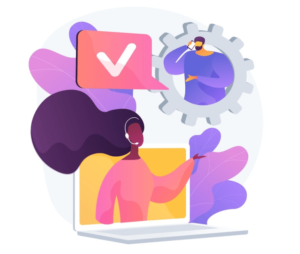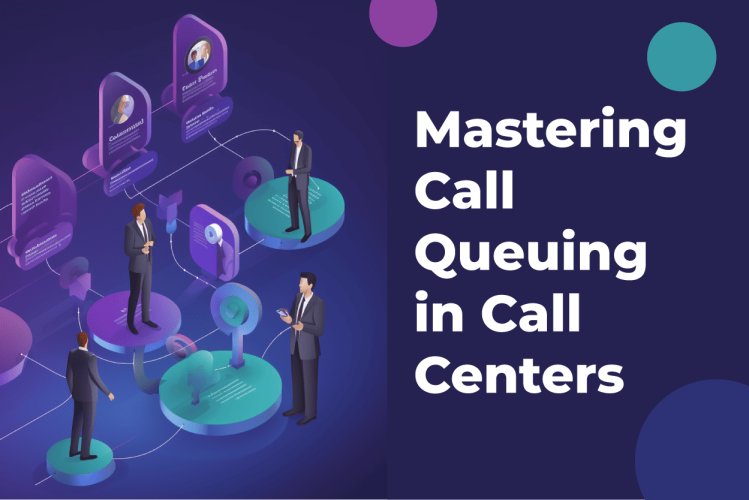In today’s rapidly-evolving business landscape, call queuing stands as a paramount component for efficient customer communications. This advanced mechanism not only ensures customers are catered to promptly but also streamlines business operations. Dive deep into the intricacies of call queuing and how it’s revolutionizing the way businesses handle customer communications.
With the right call queuing system in place, you’ll witness improved call handling, reduced wait times, and heightened agent productivity. But that’s not all – we’ll also explore how intelligent call routing and customer data integration create personalized interactions that leave a lasting impression.
Say goodbye to frustration and hello to seamless communication that keeps customers coming back. Join us as we unravel the power of call queuing and embrace the future of customer-centric excellence.
What is Call Queuing?
Call queuing is an indispensable telecommunication feature that places incoming calls in a sequence based on various criteria. This system ensures that no call goes unanswered and customers are directed to the most suitable agent available. In essence, it’s the digital waiting room of the telecommunication world.
Call queueing is the heart of modern customer communication, orchestrating a well-organized waiting system that ensures no customer is left unheard. Imagine it as a virtual queue at your favorite coffee shop, where each customer patiently waits for their turn to be served. In the contact center world, it’s a carefully designed process that efficiently manages incoming calls, keeping customers engaged with informative on-hold messages while automatically routing them to the most suitable agent. – Christian Montes, Executive Vice President of Client Operations @NobelBiz
Understanding the Foundations of Call Queuing
Picture a seamless system that gracefully manages incoming calls, preventing customers from being lost in the shuffle. This indispensable process optimizes agent availability, reduces wait times, and crafts engaging on-hold experiences. As we delve into the fundamentals, you’ll discover how call queuing empowers businesses to build lasting customer relationships and cultivate a reputation of unparalleled service.
The Science Behind the Queue
Every call that reaches a call center passes through a systematic evaluation process. Think of it as an airport’s air traffic control system: just as planes are queued and scheduled for landings based on priority and availability, calls are queued based on a set of pre-determined criteria. These might include the urgency of the call, the nature of the query, the caller’s history, and even their geographic location.
Dynamic Call Distribution
Within expansive call centers, there exists a myriad of agents, each possessing unique skill sets. Call queuing systems, leveraging advanced algorithms, match calls to agents best suited to address the specific query. For instance, in a call center servicing a software product, a technical glitch reported by a user would be queued to an agent specializing in troubleshooting, ensuring a swift and effective resolution.
The Adaptive Nature of Modern Queues
Call queuing isn’t a static system. As call centers evolve, so does the sophistication of queuing. Modern systems can adapt in real-time. If, for instance, there’s an unexpected surge in calls due to an unforeseen product issue, the system can dynamically reprioritize calls, ensuring those affected by the immediate issue are addressed first.
Enhancing Caller Experience in the Queue
Being on hold can be a test of a customer’s patience. Recognizing this, contemporary call queuing systems incorporate features to enhance the caller’s experience while they wait. This might include periodic wait time updates, options to switch to a callback system, or even the provision to navigate to self-help options if the caller prefers.
Data-Driven Insights from the Queue
Beyond managing and directing calls, modern call queuing systems are goldmines of data. By analyzing patterns, such as frequent drop-offs after a specific wait time or recurrent issues being reported, call centers can gain actionable insights. This can guide training modules for agents, infrastructure upgrades, and even feedback to the product or service teams about prevalent issues.
Expounding the Advantages: Why Call Queuing is Crucial for Business
 In the competitive landscape of modern business, ensuring top-tier customer service isn’t just a luxury, but a necessity. Central to achieving this zenith of service quality is the strategic implementation of call queuing. Let’s embark on a detailed exploration of the myriad benefits that call queuing bestows upon businesses, fortifying their position in the market.
In the competitive landscape of modern business, ensuring top-tier customer service isn’t just a luxury, but a necessity. Central to achieving this zenith of service quality is the strategic implementation of call queuing. Let’s embark on a detailed exploration of the myriad benefits that call queuing bestows upon businesses, fortifying their position in the market.
Elevating Customer Satisfaction: A Direct Line to Loyalty
A seamless call queuing system ensures every customer receives the attention they deserve, transforming mere callers into loyal advocates. By intelligently matching customers with the right agents and reducing hold times, businesses forge a direct path to customer loyalty.
A Deeper Connection with Customers
The primary aim of call queuing is to eliminate the disappointment of an unanswered call. Every answered call is an opportunity for a business to connect, assist, and build rapport. By ensuring that each customer’s call is treated as paramount, businesses send a clear message: “We value your time and concerns.”
In an advisor article, Forbes highlights the significance of call queues in optimizing customer experiences:
“While hold times are sometimes inevitable, call queues can help shorten them. By collecting customer information, a queue can quickly match a customer with an agent who can solve their problem.”
The Hold Experience
Modern call queuing systems extend beyond merely lining up calls. With features such as personalized hold music, informative messages, and updates on queue status, the time customers spend on hold is transformed from a mundane wait to an engaging experience. When customers feel informed and entertained, their perceived wait time reduces, leading to enhanced satisfaction levels.
Precision in Resource Deployment: The Art of Optimal Utilization
 With call queueing, companies orchestrate a harmonious balance between available agents and incoming calls, ensuring optimal utilization of resources. This artful approach guarantees that no customer query goes unanswered, while agents efficiently handle each interaction.
With call queueing, companies orchestrate a harmonious balance between available agents and incoming calls, ensuring optimal utilization of resources. This artful approach guarantees that no customer query goes unanswered, while agents efficiently handle each interaction.
The result? Enhanced customer satisfaction, reduced wait times, and increased productivity. Embracing the art of resource deployment with call queueing empowers businesses to stay ahead, delivering exceptional service and building lasting relationships with their clientele.
Skill-Matched Routing
In diverse businesses, not all customer queries are alike. A financial query at a bank differs vastly from a technical issue at a software company. By employing intelligent call queuing, businesses can channel specific calls to agents best equipped to handle them, ensuring swift resolutions and high levels of customer satisfaction.
Balancing Workloads
In dynamic call center environments, workload imbalances can lead to inefficiencies. Call queuing systems dynamically distribute calls, ensuring no agent is overwhelmed while others are idle. This not only boosts agent morale but also ensures consistent service quality levels.
Empowered Decision-Making: Gleaning Insights from the Queue
 In the realm of customer service, data-driven decisions reign supreme. By analyzing the call queue, businesses unlock a treasure trove of valuable insights. Every interaction becomes a window into customer needs, preferences, and pain points.
In the realm of customer service, data-driven decisions reign supreme. By analyzing the call queue, businesses unlock a treasure trove of valuable insights. Every interaction becomes a window into customer needs, preferences, and pain points.
Empowered with this knowledge, decision-makers can fine-tune strategies, optimize resource allocation, and enhance agent training. The call queue becomes more than a waiting line; it becomes a strategic tool for nurturing customer satisfaction and driving business growth. Embracing these insights fosters a customer-centric culture and paves the way for lasting success.
A Pulse on Performance
Embedded within call queuing systems are powerful analytical tools. From tracking average call durations to pinpointing recurrent issues, these tools provide businesses with a granular view of their operations. This means businesses are no longer navigating in the dark but have actionable data guiding their path.
Feedback Loops
By understanding patterns from the queue – such as common reasons for call drop-offs or peak call times – businesses can initiate feedback mechanisms. These insights can guide training programs, infrastructure investments, or even product enhancements.
Future-Proofing Operations: Scalability at its Best
The call queueing system effortlessly adapts to fluctuating call volumes, ensuring no customer is left unattended. As demands grow, resources are optimally deployed, maintaining service excellence. Future-proofing operations with call queueing enhances efficiency, boosts customer satisfaction, and preserves a competitive edge.
Embracing this powerful tool allows businesses to confidently navigate uncertainties, confidently taking on new challenges with the assurance of scalability at its best.
Growth-Ready Systems
The sign of a flourishing business is its expanding customer base. However, with growth come challenges, especially in managing increasing call volumes. Call queuing systems, with their inherent scalability, ensure that as businesses grow, customer service quality doesn’t wane. Whether it’s adding more agents, incorporating new features, or integrating with other software tools, modern call queuing systems adapt seamlessly.
Ensuring Consistent Service Standards
An increase in call volume should never dilute service standards. Call queuing ensures that even during spikes in traffic, each customer receives consistent, high-quality service. This stability ensures that a business’s reputation remains untarnished, irrespective of its size.
A well-designed call queue system plays a pivotal role in augmenting the customer experience. By efficiently managing incoming calls, minimizing wait times, and ensuring prompt and personalized assistance, it fosters a deeper sense of satisfaction and trust among customers. This heightened level of service not only encourages repeat business but also cultivates customer loyalty and retention, ultimately paving the way for sustainable long-term success for businesses. – Brad Butler, Contact Center Software Consultant @NobelBiz
Key Features of Call Queuing Systems & Their Implementation

Navigating the nuanced world of call queuing systems, one quickly discerns that it’s the features that drive efficacy. These features are the unsung heroes, working tirelessly behind the scenes to elevate customer service. Here, we’ll examine these features in-depth, spotlighting their importance and the value they bring to businesses.
Priority Queuing
This feature is akin to an intelligent traffic management system. Not only does it allow businesses to queue calls, but it also empowers them to do so with a degree of sophistication. For example:
Customer Loyalty Tiers: Regular or VIP customers might be fast-tracked, recognizing and rewarding their loyalty.
Nature of Query: A service outage report might be prioritized over a general inquiry, addressing critical issues first.
Wait Time Announcements
More than just an automated voice, this feature is a bridge of communication with the customer:
Dynamic Updates: Regularly updating customers with changing wait times ensures they feel acknowledged.
Contextual Messages: Based on the nature of the call, tailored messages might provide instant solutions or direct customers to self-help resources.
Skill-Based Routing
Beyond directing calls, this is about optimizing the entire customer-agent interaction:
Cross-Training Benefits: Agents trained in multiple domains can handle a wider array of queries, making this system even more efficient.
Feedback Integration: Post-call feedback can further refine this routing, ensuring the best agent-customer matches.
Lean more about the NobelBiz OMNI+ Skill-Based Routing System here.
Queue Callback
An acknowledgment that a customer’s time is invaluable, this feature offers flexibility:
Scheduled Callbacks: Customers can choose a specific time for the callback, aligning with their convenience.
Status Updates: Even as they await the callback, customers can be updated about their position or expected callback time.
Lean more about the NobelBiz OMNI+ Call Queue System here.
Best Practices for Call Queuing Implementation
 Beneath the technological sophistication of call queuing lies a pursuit of excellence. A commitment to constantly fine-tune and optimize this system is what yields unrivaled customer engagement. As we delve deeper into best practices for implementing call queuing, we uncover a blueprint for operational brilliance that businesses can aspire to emulate.
Beneath the technological sophistication of call queuing lies a pursuit of excellence. A commitment to constantly fine-tune and optimize this system is what yields unrivaled customer engagement. As we delve deeper into best practices for implementing call queuing, we uncover a blueprint for operational brilliance that businesses can aspire to emulate.
Call queuing implementation is the strategic fusion of efficiency and excellence, orchestrating a harmonious symphony of prompt customer service and optimized resource utilization, leading businesses towards the crescendo of heightened satisfaction and sustainable success. – Brad Butler, Contact Center Software Consultant @NobelBiz
Monitor and Adjust: Staying One Step Ahead
In the dynamic realm of call queuing, static strategies yield diminishing returns. An agile approach, rooted in real-time monitoring and responsive adjustments, propels a business to stay ahead of the curve.
Real-time Monitoring
Predictive Analysis: Dashboard views can go beyond presenting the present state, offering predictive insights. These can assist in forecasting traffic surges and preemptively deploying resources.
Customer Sentiment Analysis: Advanced systems can glean customer sentiment from voice cues. Real-time monitoring of these cues can help diffuse potential situations of customer dissatisfaction.
Lean more about the NobelBiz OMNI+ Real Time Monitoring System here.
Trend Analysis
Seasonality Insights: Trends across time can reveal seasonal patterns, informing workforce planning and infrastructure readiness.
Agent Performance Trends: Identifying patterns in agent performance metrics can guide training needs and reward programs.
Train Your Agents: Sharpening the Swords of the Frontline
A call queuing system is only as effective as the agents wielding it. A meticulous focus on agent training amplifies the impact of this potent tool.
Feature Workshops
Competency Matrix: Design workshops based on a competency matrix. This ensures every agent is skilled across all features and can handle diverse call types.
Change Management: As new features or system updates roll out, ensure all agents are adept through intensive workshops.
Scenario Simulations
Case Study Based Training: Build a repository of challenging cases and use them for training. This ensures agents are battle-ready.
Peer Learning: Facilitate scenario-based group activities where agents can learn from each other’s experiences and strategies.

If you want to step up your agent training game, we have the perfect resource to get you started:
Meet the renowned Contact Center Coach, Michael Tamer, also a training expert, CEO at Proponisi, and an accomplished author. We’re thrilled to have him as our special guest on the show, where we delve into the world of training and coaching. This podcast episode delves into topics like frontline leadership, innovative coaching techniques, and comprehensive training processes, promising an enlightening and engaging conversation!
Watch the entire podcast episode here!
Inform Callers: Building Bridges of Trust
The bond between a business and its customers is cemented in transparency. When it comes to call queuing, every moment of communication counts.
System Failures
Proactive Notification: In case of system failures, alert customers via multiple channels, minimizing the impact on their experience.
Regular Updates: If the issue persists, ensure customers are regularly updated about the resolution progress.
Alternative Channels
Multi-channel Presence: Highlight alternative channels of support prominently during hold times, ensuring customers always have an avenue for assistance.
Channel Escalation: Implement mechanisms for easy escalation to other channels if wait times exceed a threshold.

If you want to learn how to elevate trust and energy within your call center, I highly recommend you listen to Steve Bederman’s advice on the Customer Service Academy Podcast, moderated by Tony Johnson.
Listen to the entire episode here.
Integrate with CRM: Creating a Symphony of Data
Integration with CRM systems isn’t just a technical handshake; it’s a strategic alliance. The enriched data flow empowers personalized customer interactions and facilitates strategic decision-making.
Unified Customer View
Interaction History: Access to past interactions enables agents to build a narrative around the customer’s journey, resulting in more empathetic conversations.
Personalized Service: Knowledge about a customer’s preferences or habits can help agents tailor their approach, leading to more satisfying outcomes.
Post-Call Actions
Automatic Updates: Automate the process of updating call insights into the CRM. This can trigger follow-up actions and ensures nothing falls through the cracks.
Feedback Integration: Any feedback received post-call should be integrated back into the CRM. This enhances the richness of the customer profile.
Of course, having your CRM linked to your contact center software platform is critical, because data can flow in real time between your contact lists and your dialers. Not to mention that your agents can use dispositions, have instant access to the client history and edit the data from the CRM without having to leave the agent interface.
NobelBiz OMNI+ is one of the few software solutions that can provide a smooth integration between your CRM and the call center platform.
Conclusion
Call queuing is more than just a telecommunication feature; it’s a strategic tool that drives customer satisfaction and business efficiency. By understanding its nuances and implementing best practices, businesses can offer unparalleled customer service and stand out in the competitive landscape.
Incorporating a robust call queuing system is the first step towards building a future-proof customer communication strategy. By prioritizing and efficiently managing incoming calls, businesses can establish strong customer relations and drive growth.
But don’t forget, the telephone carrier used by a call center can have an influence on their call queuing system. The call queuing system relies on the underlying telephony infrastructure to manage incoming calls, handle call routing, and maintain call quality.
A reliable and robust telephone carrier with high call capacity and low latency can ensure smoother call handling and reduced wait times in the queue.
If your current carrier fails to deliver, we encourage you to explore the NobelBiz Voice Carrier Network. Our solution is carefully designed and built to serve Contact Centers and has no rivals in terms of costs and quality.

Michael McGuire is a contact center industry expert with almost two decades of experience in the space. His experience includes roles as Director of Contact Center Digital Transformation at NobelBiz, and as Director of Operations at FLS Connect, managing multiple call centers. As President of Anomaly Squared and Targeted Metrics, Michael successfully transitioned companies into remote operations and significantly boosted revenues. With a strong background in customer service, leadership, strategic planning, and operations management, Michael excels in driving growth and innovation in the call center space.
Mike is also a proud Board Member for R.E.A.C.H Trade Group, promoting consumer protection and satisfaction and Co-host of the Off Skripted Podcast – a show about Life, Call Centers and everything in between.


 English
English French
French
